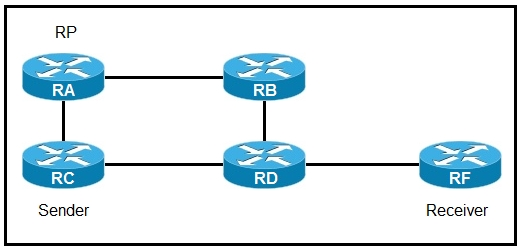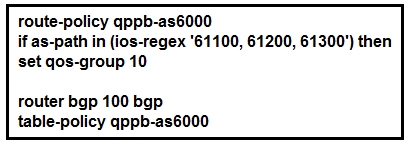
Refer to the exhibit. If router A is the RP, which PIM mode can you configure so that devices will send multicast traffic toward the RP?
A

Refer to the exhibit. Which statement supports QPPB implementation?
B
Why do packet loops occur during the configuration of BIDIR-PIM?
B
Reference:
https://www.cisco.com/c/en/us/td/docs/switches/lan/catalyst9600/software/release/16-12/configuration_guide/ip_mcast_rtng/ b_1612_ip_mcast_rtng_9600_cg/configuring_pim.html
The engineering team at a large ISP has been alerted that a customer network is experiencing high traffic congestion. After a discussion between the ISP and technical personnel at the customer site, the team agrees that traffic to the customer network that exceeds a specific threshold will be dropped. Which task must the engineer perform on the network to implement traffic policing changes?
D

Refer to the exhibit. A network administrator is implementing IGMP to enable multicast feed transmission to the receiver. Which configuration must the administrator deploy on GW1 to permit IGMP joins only to the assigned (S, G) feed?
C
A network engineer is implementing a QoS policy for outbound management traffic classification and marking on a CPE device with these requirements:
✑ Management protocols must be marked with DSCP AF class 2 with low drop probability.
✑ Monitoring protocols must be marked with DSCP AF class 1 with low drop probability.
✑ All remaining traffic must be marked with a DSCP value of 0.
Which configuration must the engineer implement to satisfy the requirements?
B
What occurs when a high bandwidth multicast stream is sent over an MVPN using Cisco hardware?
B
An engineer is implementing IGMP with SSM on a multicampus network that supports video streaming. Which task must the engineer perform as part of the process?
D
An engineer must extend Layer 2 between two campus sites connected through an MPLS backbone that encapsulates Layer 2 and Layer 3 data. Which action must the engineer perform on the routers to accomplish this task?
C
A network operator needs to implement PIM-SSM multicast configuration on a customer's network so that users in different domains are able to access and stream live traffic. Which two actions must the engineer perform on the network to make the streaming work? (Choose two.)
AE